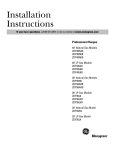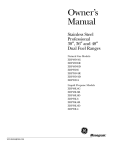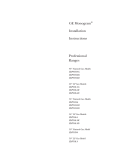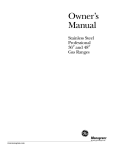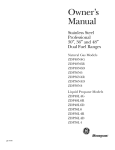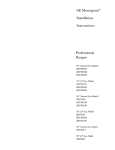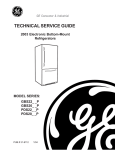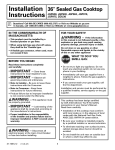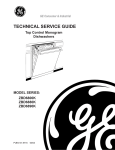Download 31-9119 GE – Monogram Dual Fuel Pro Ranges
Transcript
GE Consumer & Industrial TECHNICAL SERVICE GUIDE Monogram Dual Fuel Pro Ranges And Monogram Gas Cooktops MODEL SERIES: ZDP30_ _H ZDP36_ _ _H ZDP48_ _ _H ZGU36_ _ _H ZGU48_ _ _H PUB # 31-9119 3/04 IMPORTANT SAFETY NOTICE The information in this service guide is intended for use by individuals possessing adequate backgrounds of electrical, electronic, and mechanical experience. Any attempt to repair a major appliance may result in personal injury and property damage. The manufacturer or seller cannot be responsible for the interpretation of this information, nor can it assume any liability in connection with its use. WARNING If the information in this manual is not followed exactly, a fire or explosion may result causing property damage, personal injury or death. If you smell gas: - Do not try to light any appliance. - Do not touch any electrical switch; do not use any phone in the building. - Immediately call the gas supplier from a neighbor’s phone. Follow the gas supplier’s instructions. - If you cannot reach the gas supplier, call the fire department. WARNING To avoid personal injury, disconnect power before servicing this product. If electrical power is required for diagnosis or test purposes, disconnect the power immediately after performing the necessary checks. RECONNECT ALL GROUNDING DEVICES If grounding wires, screws, straps, clips, nuts, or washers used to complete a path to ground are removed for service, they must be returned to their original position and properly fastened. GE Consumer & Industrial Technical Service Guide Copyright © 2004 All rights reserved. This service guide may not be reproduced in whole or in part in any form without written permission from the General Electric Company. –2– TABLE OF CONTENTS Blower Thermal Cutout .................................................................................................... 16 Burner Alignment ............................................................................................................. 12 Burner Valve ..................................................................................................................... 11 Check for Proper Ignition ................................................................................................. 12 Component Access ........................................................................................................... 8 Component Locator Views ................................................................................................ 6 Components ...................................................................................................................... 8 Convection Fan Assembly ............................................................................................... 18 Door Assemblies ............................................................................................................... 9 Flame Characteristics ..................................................................................................... 11 Grates .............................................................................................................................. 12 Griddle Leveling ............................................................................................................... 15 Griddle Removal .............................................................................................................. 14 Griddle Thermostat Adjustment ....................................................................................... 15 Grill Burner/Griddle Burner Ignition Systems (On Some Models) .................................... 13 Grill or Griddle Air Adjustment .......................................................................................... 15 Grill or Griddle Igniter Removal ........................................................................................ 16 Grill Removal ................................................................................................................... 14 Ignition and Re-ignition ..................................................................................................... 12 Introduction ........................................................................................................................ 4 Lock Motor Assembly ....................................................................................................... 19 Nomenclature .................................................................................................................... 5 Orifice Conversion Kits .................................................................................................... 11 Oven Blower Motor (30-in. Range Models) ...................................................................... 20 Oven Blower Motor (36-in. and 48-in. Range Models) ..................................................... 19 Oven Door ......................................................................................................................... 8 Oven Light Bulbs ............................................................................................................. 10 Oven Select Switches ..................................................................................................... 17 Oven Thermostat ............................................................................................................. 17 Oven Thermostat Calibration ........................................................................................... 16 Relays, Convection Pulser Timers and Main Power Connection ..................................... 17 Schematics and Wiring Diagrams ................................................................................... 21 Simmer Orifice Burner Replacement .............................................................................. 11 Sparking ........................................................................................................................... 12 Spark Module ................................................................................................................... 13 Surface Burner ................................................................................................................ 10 Surface Burner Adjustments ............................................................................................ 11 Warranty .......................................................................................................................... 30 –3– Introduction The Monogram Ranges are available in 30-in. 36-in. and 48-in. configurations. The 36-in. can have 6 burners, no grill or griddle or 4 burners with grill or griddle. The 30-in. and 36-in. models have a 27-in. self-cleaning oven and the 48-in. model has an additional 12-in. standard clean oven. The gas cooktop-only models are available in 36-in. and 48-in. configurations with the same grill and griddle combinations as the cooktop on the 36-in. and 48-in. range models. All models are available in either natural gas or LP gas and must be ordered appropriately from the dealer at the time of purchase. 36-in. Range Shown with Center Grill 48-in. Range Shown with Grill, Griddle, and 12-in. Oven –4– Nomenclature Model Number Z D P 4 8 N 4 G H 1 S S Monogram Stainless Steel Eng. Digit D = Dual Fuel G = Gas Model Year G = Grill and Griddle R = Grill Only D = Griddle Only P = Self Clean U= Cooktop 4 = Surface Burners 6 = Surface Burners Width N = Natural Gas L = LP Gas Serial Number The first two numbers of the serial number identify the month and year of manufacture. Example: AG123456S = January, 2004 Mini-manual The mini-manual is located behind the bottom cover. Nomenclature information is located on the back of the range. A - JAN D - FEB F - MAR G - APR H - MAY L - JUN M - JUL R - AUG S - SEP T - OCT V - NOV Z - DEC –5– 2005 - H 2004 - G 2003 - F 2002 - D 2001 - A 2000 - Z 1999 - V 1998 - T 1997 - S 1996 - R 1995 - M 1994 - L The letter designating the year repeats every 12 years. Example: T - 1974 T - 1986 T - 1998 Component Locator Views 36-in. Range Models 4 1 2 9 3 5 6 7 8 1 - Spark Module 6 - Relays 2 - Oven Select Switches 7 - Clean Timer 3 - Oven Control 8 - Terminal Block 4 - Door Lock High Limit 9 - Transformer 5 - Gas Shut-Off Valve –6– 48-in. Range Models 4 2 1 2 3 9 5 6 7 8 1 - Spark Module 6 - Relays 2 - Oven Select Switches 7 - Clean Timer and Proof Timer 3 - Oven Control 8 - Terminal Block 4 - Door Lock High Limit 9 - Transformer 5 - Gas Shut-Off Valve –7– Components Component Access All 36-in. and 48-in. Models 1. Remove the manifold/valve panel: 30-in. Range Models 1. Remove the manifold/valve panel. (See 36-in. and 48-in. Models.) 2. Remove the landing ledge: a. Remove the knobs from the control valves. a. Remove the 4 Phillips head screws holding the landing ledge in place, and lift the ledge off. b. Remove the 4 Torx screws located at each corner of the manifold/valve panel. c. Carefully pull off the panel. (Do not scratch the panel.) 2. Remove the landing ledge: a. Slide the right-side drip tray out (models with a grill or griddle). b. Remove the 4 Phillips head screws holding the landing ledge in place, and lift the ledge off. 48-in. Range Model Shown Landing Ledge Oven Door To remove the door: 1. Fully open the door. 2. Each hinge has a hinge lock. Close the hinge latches down against the door frame. 3. Firmly grasp the door at the top sides. 4. Close the door to the near-vertical position. 5. Lift the door up and pull straight out. Hinge Lock Pull the hinge locks down to unlock. –8– To install the door: Door Gasket 1. Firmly grasp the door at the top sides. This is critical. The gasket is attached to the front frame around the outer edge of the oven liner. A series of spring clips mounts the gasket to the front frame. The ends are tucked into the front frame at the bottom of the oven liner, leaving approximately 15 inches of opening across the bottom for air intake on selfclean models. The gasket stops just above the hinges on the standard oven. 2. Approach the range with the door angled in a vertical position. 3. Guide the hinges into the slots. 4. Push the door in firmly while opening. 5. Once in position, open the door completely. Push the hinge locks back in and toward the front frame. 27-in. Oven Note: If the door cannot be fully opened, the hinge is not properly seated. Window Gasket Window Pack Insulation Door Liner Insulation Retainer Compression Brackets Handle End Cap Door Skin Hinge Handle Door Assemblies 12-in. Oven (48-in. Range Models Only) 12-in. Oven Door (48-in. Range Model Only) The oven door consists of outer and inner assemblies. The outer assembly consists of the outer panel and glass along with the handle and spacers. The inner assembly consists of the window pack, insulation guard, inner door panel and hinges. Door Liner Window Gasket Window Pack Insulation Insulation Retainer 27-in. Oven Door (30-in., 36-in. and 48-in. Range Models) The oven door consists of an outer and inner assembly. The outer assembly consists of an outer panel and glass along with the handle and spacers. The inner assembly is made up of the window pack, insulation guard, inner door panel, hinges and window pack gasket. Door Hinge –9– Door Skin Handle Oven Light Bulbs Surface Burner To remove the surface burner: Socket 1. Lift off the burner cap and burner head. Receptacle 2. Remove the burner ring locking nut using a 11/16-in. socket wrench, crescent wrench or channel-lock pliers. 3. Lift off the burner ring. Do not remove the burner base. To replace the surface burner: Bulb 1. Align the locator pins on the burner ring into the labeled hole in the burnerbase. Seat in place and push toward the electrode to set gap properly. Tab Glass cover Caution: Before replacing the oven light bulb, disconnect the electrical power to the range at the main fuse or circuit breaker panel. 2. Replace the burner ring locking nut. Tighten the nut three times to remove small imperfections in the parts. This will ensure the nut remains tight over life: • • Note: Allow light cover and bulb to cool completely. Hand tighten nut, tighten 1/4 turn with wrench or pliers, then loosen. Hand tighten nut a second time, tighten /4 turn with wrench or pliers, then loosen. 1 • Replace with a new 130V halogen bulb, not to exceed 35 watts. Hand tighten nut and final tighten 1/4 turn with wrench or pliers. 3. Align the locator pin in the burner head into the hole in the burner ring. Seat in place. To remove and replace the oven light bulb: 1. Turn the glass cover counterclockwise 1/4 turn until the tabs of the glass cover clear the grooves of the socket. 4. Replace the burner caps. Burner Cap Burner Head (Brass) 2. Using gloves or a dry cloth, remove the bulb by pulling it straight out. Locator Pins 3. Using gloves or a dry cloth, remove the new bulb from its packaging. Do not touch the bulb with bare fingers. Burner Ring (Aluminum) Burner Ring Locking Nut With Chamfer Side View Locator Pin 4. Push the bulb straight into the receptacle all the way. Place the tabs of the glass cover into the grooves of the socket. Turn the glass cover clockwise 1/4 turn to engage. Pin Slot Electrode Burner Base 5. For improved lighting inside the oven, clean the glass cover frequently using a wet cloth. This should be done when the oven is completely cool. Note: Locator Pin Fits Into Burner Base Pin Slot 6. Reconnect electrical power to the oven. – 10 – Flame Characteristics Burner Valve The burner valves are attached to the manifold by two screws and contains an orifice which sets the flow rate for the simmer flame. This valve does not have a low flame adjustment, it is controlled by the orifice size. Burner flames should be blue and stable with no yellow tips. (Yellow tipping may be normal for LP gas.) The flame should not have excessive noise or lifting of the flame from the burner. If any of these conditions exist, check the burner ports for blockage. Simmer Orifice Burner Replacement The simmer burner orifice requires a 4mm socket to remove it. If necessary a 4mm socket is available under part # WX05x10006. Main Flame Simmer Flame Orifice Conversion Kits Burner orifice conversion kits are available for: • Converting burner orifices from LP to Natural Gas and from Natural Gas to LP • Installation at high altitudes Natural/LP Conversion Kit - Order part number WB49X10132 Surface Burner Adjustments LP/Natural Conversion Kit - Order part number WB49X10133 Standard adjustments to the air shutter and gas metering orifices are not possible on sealed burners. High Altitude Conversion Kit – Order part number WB49X10130 ORIFICE/JET SIZES ORIFICE (mm) RATE (BTU/HR) SIMMER ORIFICE CODE ORIFICE/JET SIZES MAIN ORIFICE CODE If burner flames appear to be abnormal, check the following: • Check gas pressure available to the burners. The required operating pressure is 5" W.C.P. Natural Gas or 10" W.C.P. L.P. (Propane) Gas. • Check for drafts entering the burner box from behind the cooktop. • Check for blockage or partial blockage of the orifice. Inspect the orifice to be sure it has been drilled on center and is free of debris or burrs. • Check the burner alignment per Burner Alignment. • If the cause of the problem cannot be found, installing an orifice with smaller diameter openings may solve the problem. In high altitude (above 6000 ft.) installation, the orifices will usually have to be downsized. BURNER GAS MAIN SIMMER Valve HI LO SIM D BURNER D BURNER GRILL/GRIDDLE GRILL/GRIDDLE NG LP NG LP 1.85 1.18 1.93 1.32 17k 15k 18k 18k 2700 2500 6000 6000 1300 185 P 1200 118 E –––– 48 ––– –––– 55 ––– 0.57 mm 0.34 mm ––––– ––––– 0.57 0.34 0.94 0.47 HIGH ALTITUDE CONVERSION Recommended Orifice Size for High Altitude Installation Sea Level 3000 ft. 6000 ft. BURNER GAS D BURNER D BURNER GRILL/GRIDDLE GRILL/GRIDDLE NG LP NG LP – 11 – MAIN Orifice (mm) 1.85 1.18 1.93 1.32 1.78 1.09 1.85 1.32 1.61 1.07 1.70 1.18 Grates Ignition and Re-ignition To repair damaged feet on range cooktop grates, order the repair kit, part # WB2X11095. The ignition systems consists of 3 major components. • Transformer • Spark Module • Electrodes and Associated Wiring Burner Alignment Burner alignment is very important for proper operation. Make sure the locator pin on the burner ring is properly aligned with the hole on the burner base. Each brass burner head is marked with a clock face. Replace the burner head with the arrow pointing to the rear of the cooktop (12 o’clock position). Features of the cooktop determine whether the ignition system uses a 4 or 5 wire spark module. The spark modules are rated at 240v and have an internal transformer. The internal transformer serves two functions. • An isolation device to prevent random sparking in reverse polarity situations. • To increase the input voltage from 120v to 240v. During the ignition process all the electrodes will spark simultaneously when any burner is selected. Once the ignition process is complete, the flame ionizes the surrounding air which completes the sensing circuit and satisfies the module that a flame is present. Sparking Check For Proper Ignition All the igniters make clicking sounds and spark even when only a single burner is being turned on. Do not touch any of the burners when the igniters are clicking. 1. Push in one control knob and turn 90° to LITE position. • Input voltage should be 240 VAC and the ground line should be properly connected to the range chassis. Voltage should be measured on one leg of the power supply. • Make sure electrical circuit is properly polarized. • If the igniter electrodes continue to spark after the burners are lit, check that each burner component is assembled and seated properly by observing uniform gaps between each layer. Disassemble and reassemble as required. • If water spills onto the electrode, the burner will not reignite. The wet electrode will conduct spark energy to ground, preventing it from sparking or sensing flame across the spark gap. The burner will operate normally once the electrode and wiring connections are dry. 2. The igniter will spark and the burner will light; the igniter will cease sparking when the burner is lit. 3. The first test may require some time while air is flushed out of the gas line. 4. Turn knob to OFF. 5. Repeat the procedure for each burner. – 12 – Grill Burner/Griddle Burner Ignition Systems (On Some Models) Spark Module All 36-in. and 48-in. models have a single spark module located behind the manifold/valve panel. To remove the module: 1. Remove the manifold/valve panel (see Component Access). 2. Remove the screws at the upper-right and lower-left corners of the module. 3. Pull the module up and out. 36-in. Model Shown The grill burner and griddle burner are ignited by Norton style glowbar ignition systems. The ignition circuit consists of the grill switch (grill burner only), griddle thermostat (griddle burner only), the igniter and the thermal/safety valve (gas valve). The components are wired in series for each cooking function. Note: The igniter resistance decreases as the igniter surface temperature increases. The safety valve operates by current, not by voltage. From a cold start, the igniter needs 30–60 seconds, with voltage applied, to reduce its electrical resistance enough to provide a minimum of 3.2 - 3.6 amps of current flow in the series circuit. This is the required current flow needed for the safety valve to open and supply gas to the burner. The glowbar should provide a steady current flow of 3.2 to 3.6 amps flowing in the circuit. At that point, the igniter temperature is between 1800°F and 2500°F. The igniter will remain energized at all times during burner operation. If the igniter glows red but does not draw at least 3.2 - 3.6 amps, the fault is usually with the igniter, not the valve. 30-in. Range Models 30-in. range models have a single spark module located in the center of the burner box. Spark Module To remove the module: 1. Remove the burner grates. 2. Lift off the center trim from the burner maintop. 3. Remove the 2 screws at the front and rear of the air duct cover, and remove the cover. 4. Remove the 2 screws securing the spark module to the range. – 13 – Grill Removal Griddle Removal To remove the grill burner assembly: To remove the griddle assembly: 1. Remove the grill cover, grill grates and grill radiant. 1. Remove the griddle cover. 2. Lift off the front trim from the front of the grill. 2. Lift off the front trim from the front of the griddle. 3. Remove the 2 Phillips head screws at the front of the grill box that secure the grill box to the cooktop. 3. Remove the 2 Phillips head screws at the front of the griddle that secure the griddle to the cooktop. 4. Carefully lift up the grill box enough to access the wire nut connecting the igniter to the neutral, and unscrew the nut. Unplug the wire going to the valve. 4. Remove the rear cover from the rear of the griddle. 5. Lift the grill up and off the cooktop. 5. Remove the center shipping screw and washer, if they have not already been removed. Note: Do not remove the 2 outer leveling screws. Grill Cover 6. Lift the griddle assembly out of the opening and pull out the thermostat capillary from beneath the plate. Leveling Screws Grill Grates Burner Grill Radiant Rear Cover Igniter Griddle Plate Assembly Griddle Cover Front Trim Igniter Grill Box Burner Front Trim Griddle Baffle – 14 – Grill or Griddle Air Adjustment Griddle Leveling 1. For the grill, remove the grill cover, grates and grill radiant. For the griddle, remove the griddle assembly (see Griddle Removal). The 2 screws at the rear of the griddle plate assembly are leveling screws. They can be turned to level the griddle or to provide a forward slope to help grease and oils to drain away from the food being cooked. 2. If adjusting the grill air shutter, remove the 2 Phillips head screws at the rear of the burner and lift the burner out. 3. Loosen the screw on the burner air shutter using a flat head screwdriver. Griddle Thermostat Adjustment To adjust the griddle thermostat: 1. Pull the griddle control knob off. 2. On the back of the knob, loosen both screws, but do not completely remove. 3. With the back of the knob facing you, hold the outer edge of the knob with one hand and turn the back of the knob with the other hand. 4. To raise the griddle temperature, turn the back of the knob clockwise. To lower the griddle temperature, turn the back of the knob counterclockwise. 4. Using a flat head screwdriver, move the air shutter in the appropriate direction. If the flame is too yellow, indicating insufficient air, adjust the shutter counterclockwise to increase the airflow. If the flame is too low or tends to lift away from the burner, indicating too much air, turn the shutter clockwise to reduce the airflow. 5. Test and adjust as needed for proper flame characteristics. 5. After the adjustment is made, retighten screws so they are snug, and replace knob. Ð20û Ð10û GRIDDLE HO T/ Ð24û LD +24û CO +12û Ð12û OVEN +20û +10û – 15 – Oven Thermostat Calibration Grill or Griddle Igniter Removal 1. For the grill, remove the grill cover, grates and grill radiant. For the griddle, remove the griddle assembly (see Griddle Removal). 2. Remove the 2 Phillips head screws at the rear of the burner and lift the burner out. The AVERAGE center oven temperature should be 350° ±15°F for baking at the 350°F setting. Customers may change the average center oven temperature by ±24°F to satisfy their own cooking needs. To adjust the oven thermostat: 3. Remove the 2 flat head screws holding the igniter to the support bracket on the burner. 1. Pull the oven control knob off. 4. Replace with new igniter and replace all parts. Note: When aligned properly, the dimple on the igniter bracket should fit into the notch on the support bracket on the burner. 2. On the back of the knob, loosen both screws, but do not completely remove. 3. With the back of the knob facing you, hold the outer edge of the knob with one hand and turn the back of the knob with the other hand. 4. To raise the oven temperature, turn the back of the knob clockwise. To lower the oven temperature, turn the back of the knob counterclockwise. Igniter 5. After the adjustment is made, retighten screws so they are snug, and replace knob. Ð20û Ð10û GRIDDLE HO T/ Ð24û LD +24û CO +12û Ð12û OVEN +20û +10û Burner GRILL OR GRIDDLE OHMMETER TEST COMPONENT IGNITER VALVE SWITCH OHMS 45–400 OHMS COLD 1.0 to 1.2 OHMS 0 OHMS CLOSED GRILL L1 N HEAT LIGHT Blower Thermal Cutout GRILL SWITCH NC C VALVE IGNITER GRIDDLE L1 N The thermal cutout will turn on the blower in any mode of operation when it detects a temperature in the control area of approximately 210°F. The blower will cycle off when temperatures cool below 120°F. HEAT LIGHT GRIDDLE SWITCH NO C THERMOSTAT VALVE IGNITER – 16 – Oven Select Switches Relays, Convection Pulser Timers and Main Power Connection Select switch operation can be checked with ohmmeter and strip circuits that show what contacts are closed in each mode of operation. Electrical relays and timers are located in the compartment below the oven. Remove the 2 screws from the top corners of the bottom panel and pull straight off. 27-in. Oven 32 30 28 26 24 22 20 18 16 14 12 10 31 29 27 19 17 11 9 48-in. Range Models Convection Broil Unit Pulsar K2 Relay Clean Lockout Relay Proof Timer Clean Timer K1 Relay K4 Relay K3 Relay Terminal Block 12-in. Oven 61 59 57 55 53 51 49 58 56 47 45 43 41 48 46 46 42 40 30-in. and 36-in. Range Models Convection Broil Unit Pulsar Terminal Block Clean Timer K3 Relay K4 Relay K1 Relay Oven Thermostat The operation of the thermostat contacts can be checked with an ohmmeter and strip circuits. Contacts 1 and 2 are the cycling contacts, which are controlled by the expansion and contraction of the helium in the capillary. Contacts 7 and 8 will always be in the CLOSED position, except when in the CLEAN mode of operation. (See above illustration.) – 17 – Convection Fan Assembly The convection fan assembly is located behind the large oven liner. To remove the convection fan assembly: 1. Disconnect power and remove the oven door and racks. 2. Loosen the fan cover mounted by 4 screws and spacers. Lift the cover off the keyhole opening. 3. Remove the 4 screws securing the fan assembly to the mounting plate. 4. Carefully pull the fan assembly into the oven. Note: Fan assembly is heavy. 5. Disconnect the wires to remove the assembly from the oven, and place the assembly on a flat surface for repair. 36-in. and 48-in. Range Models Convection Oven Cavity Fan Cover Back Spacer (4) Convection Fan Cover Convection Fan Assembly Mounting Screws (4) 5/32 Blade Mounting Screw (Allen) Start/Run Capacitor Cover Mounting Screws (4) Convection Fan Blade Wiring Compartment Cover Motor Cooling Fan Blade Convection Fan Motor Convection Fan Motor Mounting Plate Insulation 5/22 Blade Mounting Screws (Allen) (2) Convection Fan Assembly Mounting Plate 30-in. Range Models – 18 – Lock Motor Assembly LOCKING L2 The lock motor assembly is located at the center top of the oven front frame. The assembly consists of the mounting plate, motor, micro switches, cam and hook assembly. L1 120V. LATCH "CLOSED" SW C 31 LOCK LIGHT K3 RELAY SEL SW NC 32 9 6 NO 2 NC 8 K3 RELAY COIL K3 RELAY 8 NO 5 A B K3 RELAY To access the assembly: 7 1. Open the oven door. UNLOCKING LM 4 NO L2 L1 120V. 2. Remove the 2 Torx screws securing the mounting plate to the front frame and pull the assembly out. K4 RELAY COIL A LATCH "OPEN" SW C Door lock motor operation: NC K4 RELAY 9 1. When the oven controls are set for CLEAN, power is applied to the K3 relay coil, which will energize the lock motor. 2. The lock motor drives the cam that closes the latch CLOSED switch. As the lock hook engages, the motor position switch will open, supplying power to the K1 relay, which turns the clean timer on. 3. At the end of the clean cycle, when the select switch is pushed to off or another mode of operation, the K4 relay will energize the lock motor to drive the cam to the unlock position. SEL SW 29 B K4 RELAY T STAT 7 30 4 CLOSED < 550˚F 6 NO K3 RELAY 9 LOCK LIGHT 3 NO LM Oven Blower Motor (36-in. and 48-in. Range Models) The blower motor assemblies are located on the back of the range above each oven. The air switch on the blower motor completes the circuit to the oven thermostat. Air Switch Motor Position Switch Fan Assembly Lock Motor Mounting Plate Screws (4) Blower Thermostat Fan Thermostat Motor Mounting Screws (2) Fan Mounting Plate To remove the blower assembly: Mounting Plate 1. Remove the cooktop burner assemblies. 2. Remove the 4 screws securing the fan mounting plate, and pull the plate with attached blower motor forward. 3. Remove the blower motor from its mounting plate by loosening the 2 screws on the plate and sliding the blower to the right. 4. Install in reverse order. – 19 – Oven Blower Motor (30-in. Range Models ) The blower motor assembly is located on the back of the range above the oven. The air switch on the blower motor completes the circuit to the oven thermostat and hot wire relay. To remove the blower assembly: Reignition Module Screw 1. Lift off the burner cap. 2. Remove the left-side burner assembly and disconnect the ignition wires. 7. On the spark module, cut the wire tie securing the module, and disconnect the spark module from the wire harness by pulling straight off the connector. Spark Module Connector 3. Remove the screws at the front and back of the air duct cover to reveal the spark module. (See Spark Module.) 8. Lift the air duct out (with the wires still connected to the spark module), and set it aside. 4. Lower the manifold/valve panel. (See Component Access). 5. Locate the bracket holding the oven thermostat in place. Remove the 2 screws securing the bracket, and pull the thermostat out of the way to reveal the re-ignition module bracket. 9. Locate the blower motor cover at the center rear of the burner box. Remove the 2 screws securing the blower motor cover, and lift the blower motor up and into the burner box. 6. Remove the screw from the re-ignition module bracket. Screw Blower Motor Cover – 20 – Screw Schematics and Wiring Diagrams WARNING: Disconnect electrical power before servicing. Caution: Label all wires prior to disconnection. Wiring errors can cause improper and dangerous operation. Verify operation after servicing. Oven Circuits BAKE 27-in Oven L2 CONVECTION BAKE L2 L1 L1 240V. 11 11 ON LIGHT SEL SW 19 FAN T STAT 20 T STAT T STAT 8 2 7 ON LIGHT HEAT LIGHT BAKE UNIT 12.92A 1 4.17A 3100W BROIL BROIL UNIT 1 UNIT 2 2000W HIGH TEMP CUTOUT SEL SW 12.92A 10 19 9 16 T STAT 8 2 7 1 3100W BROIL BROIL UNIT 1 UNIT 2 2000W L1 10 9 50% 4.17A PULSER SEL SW 14 2000W 9 • The Convection Fan will turn on as soon as the CONV switch is pressed and will remain on until the OFF switch is pressed or another mode of operation is selected. • Throughout the convection mode, anytime the bake unit cycles on, the broil unit will be cycled at approximately a 50% rate at 120 volts. N CLEAN L2 ON LIGHT HEAT LIGHT K1 RELAY 7 FAN T STAT 1 SEL SW 50 SEL SW 51 48 T STAT 49 8 T STAT 7 L1 240V. 42 BAKE UNIT 11.67A SEL SW 11.67A 41 40 2800W BROIL BROIL SEL UNIT 1 UNIT 2 SW 3.75A 3.75A 41 40 1800W 1800W HIGH TEMP CUTOUT LATCH "CLOSED" SW C N BM 4 NO 27 CLEAN TIMER K1 RELAY COIL SEL SW 28 A B 1 N 2 HEAT LIGHT ON LIGHT BROIL 27-in Oven L2 SEL SW L1 19 FAN T STAT K1 RELAY 22 6 T STAT 2 9 19 26 N BM 1 8 2 11 ON LIGHT SEL SW FAN T STAT SEL SW 8 22 T STAT 7 2 L2 BROIL UNIT 1 8.3A 1 8.3A 12 2000W SEL SW 17 8.3A 18 BROIL UNIT 2 HIGH TEMP CUTOUT SEL SW 17 18 8.3A 12 BROIL UNIT 2 9 8.3A 2000W 12-in. Oven Only PROOF HEAT LIGHT SEL SW HIGH TEMP CUTOUT SEL SW 8.3A 2000W WILL NOT OPERATE WHEN SELECT BUTTON IS SET FOR CLEAN GRILL GRIDDLE 12" OVEN OVEN LIGHT K1 RELAY BROIL UNIT 1 8.3A 240V. SEL SW 19 HIGH TEMP CUTOUT SEL SW 12.92A 240V. B 3 BAKE UNIT 12.92A 9 BAKE 12-in. Oven K5 RELAY COIL A 20 T STAT 4.17A • During bake operation the broil unit is on 1/4 wattage while bake unit is energized. L2 FAN T STAT SEL SW 4.17A 2000W SEL SW HEAT LIGHT L1 240V. 58 K5 RELAY COIL 8.3A 2000W A B CLEAN TIMER K2 RELAY COIL SEL SW 9 59 A 1 B N 2 N 42 ON LIGHT HEAT LIGHT BROIL 12-in. Oven L2 L1 FAN T STAT 240V. SEL SW 56 57 3 N BM K5 RELAY COIL A N B 42 ON LIGHT FAN T STAT 3 1 SEL SW 50 53 SEL SW 48 49 HEAT LIGHT T STAT T STAT 8 2 7 BROIL UNIT 1 7.5A SEL SW 46 47 7.5A 43 BROIL UNIT 2 HIGH TEMP CUTOUT SEL SW 7.5A 1800W 1 40 7.5A 1800W – 21 – 1 SEL SW 50 55 7 NO BROIL UNIT 1 4 1800W 3.75A BROIL UNIT 2 1800W 3.75A HIGH TEMP CUTOUT SEL SW 45 40 36-in. Range Wiring Diagram – 22 – 36-in Range Schematic – 23 – 48-in. Range Wiring Diagram – 24 – 48-in Range Schematic – 25 – 30-in Range Schematic – 26 – 30-in. Range Wiring Diagram – 27 – Gas Cooktop Wiring Diagram – 28 – Gas Cooktop Wiring Schematic – 29 – Warranty MONOGRAM RANGE WARRANTY Proof of original purchase date is needed to obtain service under warranty. WHAT IS COVERED FULL ONE-YEAR WARRANTY For one year from date of original purchase, we will provide, free of charge, parts and service labor in your home to repair or replace any part of the range that fails because of a manufacturing defect. LIMITED FIVE-YEAR WARRANTY For five years from the date of original purchase, we will provide, free of charge, replacement gas surface burners if they fail in normal household use. (The grill, griddle and oven burners are not included.) You pay for the service trip to your home and all service labor charges. WHAT IS NOT COVERED This warranty is extended to the original purchaser and any succeeding owner for products purchased for ordinary home use in the 48 mainland states, Hawaii and Washington, D.C. In Alaska the warranty is the same except that it is LIMITED because you must pay to ship the product to the service shop or for the service technician’s travel costs to your home. All warranty service will be provided by our Factory Service Centers or by our authorized Customer Care® servicers during normal working hours. Should your appliance need service, during warranty period or beyond, in the U.S.A. call 800.444.1845. In Canada: 888.880.3030. • Service trips to your home to teach you how to use the product. • Damage to the product caused by accident, fire, floods or acts of God. • Discoloration of the griddle plate. • • Chipping of porcelain enamel grates. Failure of the product if it is used for other than its intended purpose or used commercially. • Replacement of house fuses or resetting of circuit breakers. • • Incidental or consequential damage caused by possible defects with this appliance. • Damage after delivery. Improper installation, delivery or maintenance. If you have an installation problem, contact your dealer or installer. You are responsible for providing adequate electrical, gas, exhausting and other connecting facilities as described in the Installation Instructions provided with the product. Some states do not allow the exclusion or limitation of incidental or consequential damages, so the above limitation or exclusion may not apply to you. This warranty gives you specific legal rights, and you may also have other rights which vary from state to state. To know what your legal rights are in your state, consult your local or state consumer affairs office or your state’s Attorney General. Warrantor: General Electric Company. If further help is needed concerning Natural Gas Models ZDP48N4G ZDP48N6R ZDP48N6D ZDP36N6 ZDP36N4R ZDP36N4D ZDP30N4 Liquid Propane Models ZDP48L4G ZDP48L6R ZDP48L6D ZDP36L6 ZDP36L4R ZDP36L4 DZDP30L4 – 30 –































